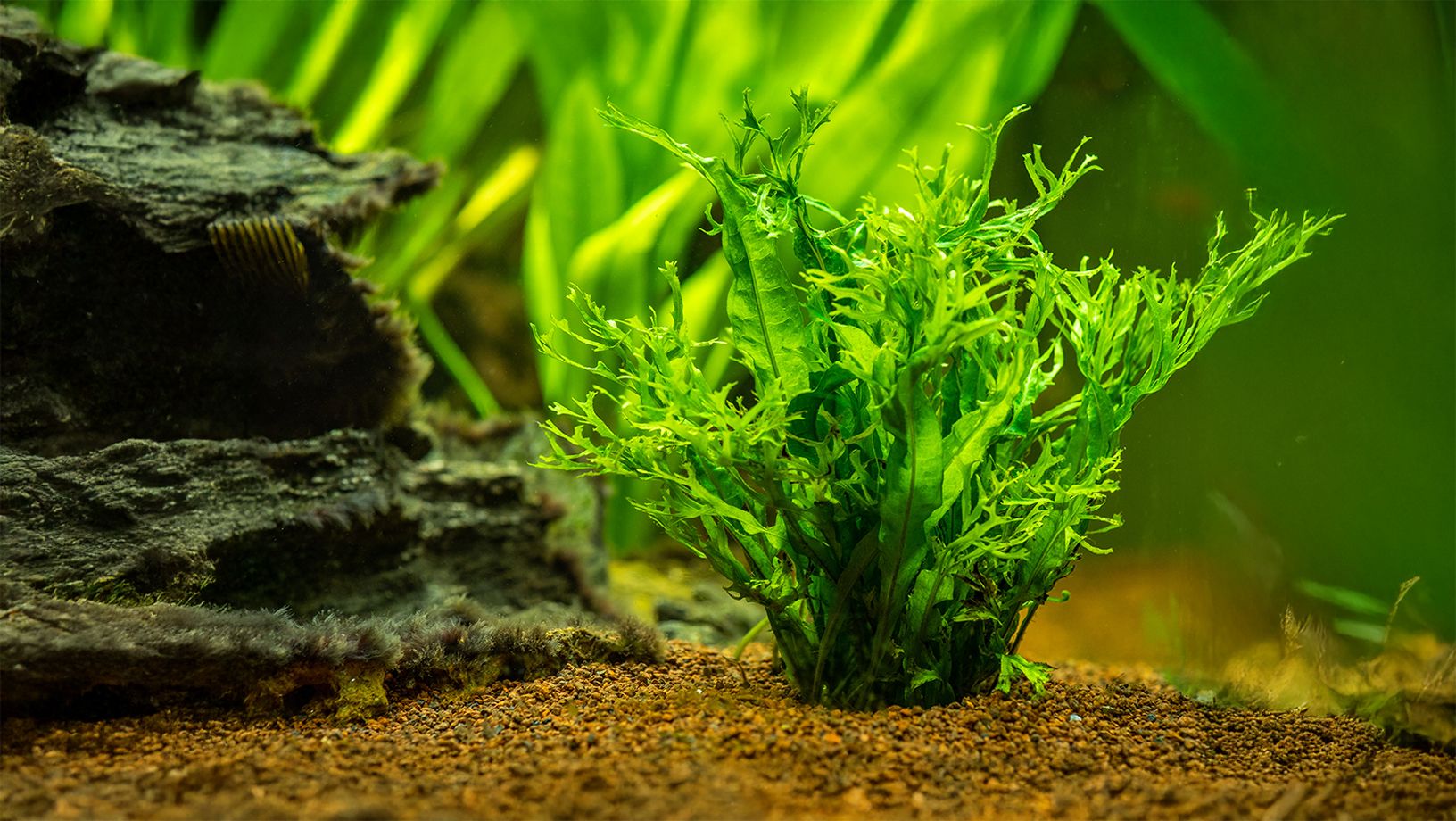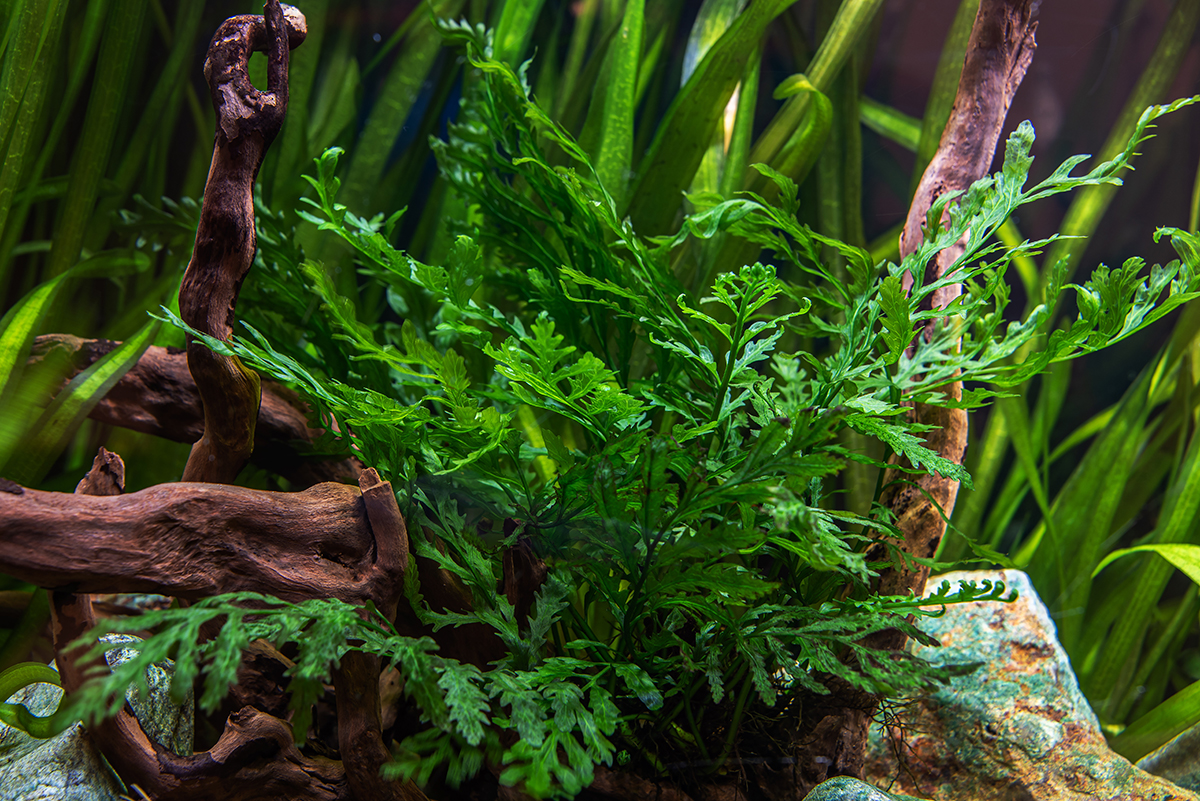Aquatic Plants Care Guide

In this Article
Tropical & Tranquil Aquatic Plants
When established and cared for properly, aquatic plants can thrive in any size aquarium and help regulate its ecosystem by removing harmful chemicals from the water.
Aquatic plants use the waste products from fish (primarily ammonia) to grow, helping to maintain your water quality with a beautiful addition to your tank. Plants add a new dimension to any aquarium and fish love having live plants to rest in.
Plants are usually broken down into categories by light requirements. Another consideration is that some plants require a Carbon Dioxide source in addition to what your fish produce. Plants also benefit from regular addition of fertilizers.
How do I maintain healthy plants?
- Plants require regular maintenance; plan to tend them at least once a week, depending on the species and environmental conditions.
- Replant and prune as necessary, and when adding aquarium plant fertilizers follow manufacturer recommendations.
- LIQUID FERTILIZERS: Typically contain iron, potassium, and other nutrients that plants need to thrive.
- ROOT TABS: Dissolve over time to provide a slow release of nutrients for the plant roots.
- Peaceful community fish are less likely to interfere with the live plants.
- Many larger fish such as large cichlids may uproot plants and/or eat them.
- Many types of algae eaters will eat plants, so avoid species known to do this.
- Some plants such as Anubias sp. and Java Fern grow on a rhizome and do best when attached to decorations like natural rocks or driftwood. It may require using thread to attach the plants to the decorations, at first, but over time the roots will connect them permanently.
- If planting in the substrate, be careful not to completely bury the rhizome, which may cause it to rot and kill the plant.
- Other plants, like Amazon Swords, root into the substrate and may need weighed down until their roots are established.
- Stem plants like Bacopa, Ludwigia, and Rotala do not root deeply and may float until they develop a root system.
Types of Aquatic Plants by Light Level

Aquatic plants are often categorized by how much light they need. Some thrive in low-light tanks, while others require high-output lighting and carbon dioxide (CO₂) supplementation.
Low Light Aquatic Plants
These are ideal for beginner plant keeper and tanks without specialized lighting. Some, like Java Fern and Anubias, grow on driftwood or rocks instead of rooting in substrate.
Size: 4-16” depending on species
Examples: Anubias, Windelov, Java Fern (Microsorum sp.), Amazon Sword (Echinodorus sp.), Hairgrass (Eleocharis sp.), El Nino Fern (Bolbitis sp.), Staurogyne repens
Tank Size: 1+ gallon
Water Temp: 78-82° F (25-27° C)
Habitat: Planted tank substrate to nourish the roots
Light Requirements: 35-75 lumens per gallon
Carbon Dioxide Requirement: None
Fertilization: Amazon Swords and Staurogyne repens benefit from routine fertilization
Medium Light Aquatic Plants
These plants offer more variety in leaf shape, growth pattern, and color. Most root in substrate but may also absorb nutrients through leaves.
Size: 4-12” depending on species
Examples: Miniature Hairgrass (Eleocharis sp.), Cardinal (Lobelia sp.), African Water Fern (Bolbitis sp.), Rosette Sword (Echinodorus sp.), Aponogeton sp, Rotala indica
Tank Size: 1+ gallon
Water Temp: 78-82° F (25-27° C)
Habitat: Planted tank substrate to nourish the roots
Liqht Requirements: 75-150 lumens per gallon
Carbon Dioxide Requirements: None but does benefit from it
Fertilization: These benefit from routine fertilization
High Light Aquatic Plants
These plants are outstanding in an aquascaped, high-tech aquarium. They require very bright lighting, a CO₂ system, and fertilizer routines to thrive.
Size: 4-10” depending on species
Examples: Dwarf Baby Tears (Micranthemum umbrosum), Glossostigma ciestanthum, Rotala macranda
Tank Size: 1+ gallon
Water Temp: 78-82° F (25-27° C)
Habitat: Planted tank substrate to nourish the roots
Light Requirements: 150+ lumens per gallon
Carbon Dioxide Requirements: Highly recommended
Fertilization: These require routine fertilization
Setting Up a Planted Tank
Typical Planted Aquarium:
- Glass or acrylic tank
- Hood or tank cover with light
- Thermometer
- Plant-specific substrate
- Décor
- Community fish
- Heater
- Filter
Setup Steps:
- Choose your equipment: Select an appropriately sized tank, substrate, décor, heater, and filter. A PetSmart associate can help guide your selections.
- Prepare your space: Place the aquarium on a flat, stable surface that can support its full weight - water weighs 8.3 pounds per gallon.
- Rinse and place décor: Rinse all substrate and decorations with tap water (never soap), then add to the tank.
- Add water and conditioner: Fill with tap water and use a water conditioner to remove chlorine and chloramines. If your home uses a water softener, use a tap source that bypasses it.
- Install and test equipment: Set up the heater, filter, and thermometer per manufacturer instructions. Add the hood and lighting and set lights on a 12-hour cycle using a timer for consistency.
- Let the tank stabilize: Run the system for at least 24 hours to ensure all equipment works and the water temperature is stable.
- Begin cycling the tank: Add a beneficial bacteria starter and introduce just a few hardy fish to start, or follow a fishless cycling process to reduce stress.
- Monitor water quality daily: During cycling, test water regularly. Perform a water change if ammonia or nitrite is above 0 ppm or if nitrate exceeds 20 ppm. Always add water conditioner after each change.
- Introduce Plants Safely and Prevent Pests: If you’re adding tissue culture plants (grown in sealed containers), they are generally pest-free. However, potted plants from wet displays may carry snails, scuds, planaria, or other unwanted hitchhikers. To minimize the risk of introducing pests: Dip plants in a mild hydrogen peroxide solution: mix ½ teaspoon of 3% hydrogen peroxide per 1 gallon of water, submerge the plants for 20 minutes, and rinse thoroughly under running water.
- For extra precaution, quarantine new plants in a separate, cycled tank for 30 days before introducing them into your main aquarium. This helps reduce the risk of introducing disease or nuisance organisms to your setup.
Learn more about fish-less cycling in Setting Up an Aquarium.
When should I test my water quality?
- Fish are sluggish, near the bottom of the tank
- Fish are at the top, breaking the water to breathe
- Fish are not eating
- Sudden behavior changes in your fish
- Water is cloudy
- Water smells funny
- Plants are “melting” or decaying
PetSmart offers free water quality testing and one of our knowledgeable associates can help you get your system balanced.
Aquatic Plant Shopping Checklist
What will I need for my planted tank?
- Aquarium sized appropriately for the plants and fish you intend to get
- Aquarium top/hood with light fixture
- Planted tank substrate & gravel vacuum
- Tank décor like driftwood or ornaments
- Live plants
- Aquarium heater and thermometer
- Aquarium filter sized for your tank
- Water testing kit or strips
- Water conditioner/dechlorinator
- Beneficial bacteria starter
- Algae cleaning pad or scraper
- Fertilizer
Ready to learn more?
This guide is a great starting place, but we encourage you to do more research on the individual species that you are keeping so that you can be as successful as possible with your aquarium!
Related guides:
Vet Assured™: Pets purchased at PetSmart are part of our exclusive Vet Assured™ program, designed by PetSmart veterinarians to help improve the health and well-being of our pets. Our vendors meet a high
standard in caring for pets and screening them for common illnesses. This program also includes specific standards for in-store pet care.
The PetSmart Promise: If your pet becomes ill during the initial 14-day period, or if you’re not satisfied for any reason, PetSmart will gladly replace the pet or refund the purchase price.
Safety tips for you and your pet:
1. ALL ANIMALS can potentially carry viral, bacterial, fungal, and parasitic diseases contagious to humans. 2. Thoroughly wash your hands with warm, soapy water before and after contact with any pet or its habitat. 3. Adults should assist children with hand washing after contact with a pet, its habitat or aquarium water. 4. Always add a dechlorinator or water conditioner and bacteria starter to tap water before adding it to the aquarium. 5. Do not use soaps or detergents to clean aquarium or decor, since they are toxic to fish. For more information, visit petsmart.com, cdc.gov/healthypets, or contact your veterinarian.
This care guide contains general information for the proper care of your pet, but is not comprehensive and is not a substitute for veterinary advice or care. PETSMART and VET ASSURED are trademarks of PetSmart Home Office, Inc. © 2025 PetSmart. All rights reserved.
standard in caring for pets and screening them for common illnesses. This program also includes specific standards for in-store pet care.
The PetSmart Promise: If your pet becomes ill during the initial 14-day period, or if you’re not satisfied for any reason, PetSmart will gladly replace the pet or refund the purchase price.
Safety tips for you and your pet:
1. ALL ANIMALS can potentially carry viral, bacterial, fungal, and parasitic diseases contagious to humans. 2. Thoroughly wash your hands with warm, soapy water before and after contact with any pet or its habitat. 3. Adults should assist children with hand washing after contact with a pet, its habitat or aquarium water. 4. Always add a dechlorinator or water conditioner and bacteria starter to tap water before adding it to the aquarium. 5. Do not use soaps or detergents to clean aquarium or decor, since they are toxic to fish. For more information, visit petsmart.com, cdc.gov/healthypets, or contact your veterinarian.
This care guide contains general information for the proper care of your pet, but is not comprehensive and is not a substitute for veterinary advice or care. PETSMART and VET ASSURED are trademarks of PetSmart Home Office, Inc. © 2025 PetSmart. All rights reserved.

